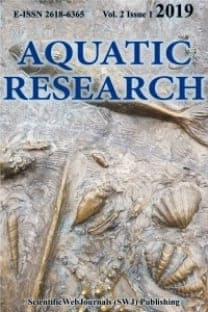Biological control of invasive zebra mussel (Dreissena polymorpha) in a freshwater ecosystem through Potamon ibericum
___
Aksu, Ö., Yabanli, M., Can, E., Kutluyer, F., Kehayias, G., Can, Ş.S., Demir, V. (2012). Comparison of heavy metals bioaccumulation by Dreissena polymorpha (Pallas, 1771) and Unio elongatulus eucirrus (Bourguignat, 1860) from Keban Dam Lake, Turkey. Fresenius Environmental Bulletin, 21(7 A), 1942-1947.Aksu, S., Yıldız, D. (2017). Dünyada ve Türkiye'de HES’lerde ve Su İletim Sistemlerindeki Zebra Midye Sorunu. World Water Diplomacy & Science News, 1-4.
Amberg, J.J., Merkes, C.M., Stott, W., Rees, C.B., Erickson, R.A. (2019). Environmental DNA as a tool to help inform zebra mussel, Dreissena polymorpha, management in inland lakes. Management of Biological Invasions, 10(1), 96. https://doi.org/10.3391/mbi.2019.10.1.06
Angarano M., McMahon R.F., Hawkins D.L., Schetz J.A. (2007). Exploration of structure-antifouling relationships of capsaicin-like compounds that inhibit zebra mussel (Dreissena polymorpha) macrofouling, Biofouling, 23:5, 295-305. https://doi.org/10.1080/08927010701371439
Bobat, A., Hengirmen, M.O., Zapletal, W. (2004). Zebra mussel and fouling problems in the Euphrates Basin. Turkish Journal of Zoology, 28(2), 161-177.
Costa, R., Aldridge, D.C., Moggridge, G.D. (2011). Preparation and evaluation of biocide-loaded particles to control the biofouling zebra mussel, Dreissena polymorpha. Chemical Engineering Research and Design, 89(11), 2322-2329. https://doi.org/10.1016/j.cherd.2011.02.027
Costa, R., Aldridge, D.C., Moggridge, G.D. (2012). Multicomponent molluscicide mixtures for zebra mussel control. Journal of Great Lakes Research, 38(2), 317-325. https://doi.org/10.1016/j.jglr.2012.03.010
Coughlan, N.E., Cunningham, E.M., Potts, S., McSweeney, D., Healey, E., Dick, J.T., Cuthbert, R.N. (2020). Steam and Flame Applications as Novel Methods of Population Control for Invasive Asian Clam (Corbicula fluminea) and Zebra Mussel (Dreissena polymorpha). Environmental Management, 66(4), 654-663. https://doi.org/10.1007/s00267-020-01325-1
Darrigran, G. (2002). Potential impact of filter-feeding invaders on temperate inland freshwater environments. Biological invasions, 4(1-2), 145-156. https://doi.org/10.1023/A:1020521811416
Demirsoy, A. (1998). Yasamın Temel Kuralları (Böcekler dışında omurgasızlar). Cilt 2. Kısım I. Metaksan A.S.. Ankara. 1210 s.
Dobson, M., Magana, A.M., Lancaster, J., Mathooko, J.M. (2007). Aseasonality in the abundance and life history of an ecologically dominant freshwater crab in the Rift Valley, Kenya. Freshwater Biology, 52(2), 215-225. https://doi.org/10.1111/j.1365-2427.2006.01648.x
Drake, J.M., Bossenbroek, J.M. (2004). The potential distribution of zebra mussels in the United States. BioScience, 10, 931-941. https://doi.org/10.1641/0006-3568(2004)054[0931:TPDOZM]2.0.CO;2
DSİ (Devlet Su İşleri) (1969). Kovada II. Hidroelektrik santralında midye sorunu ve su mecralarının midye üremesinden ve korozyondan korunmasıyla ilgili olarak yapılan elektroşimik tecrübelerin neticeleri. T.C. Enerji ve Tabii Kaynaklar Bakanlığı, DSİ Genel Müdürlüğü, İşletme ve Bakım Dairesi Başkanlığı, Ankara.
DSİ (Devlet Su İşleri) (2005). Hidroelektrik santrallarda sorun yaratan zebra midye araştırmaları raporu. DSİ Genel Müdürlüğü İşletme ve Bakım Dairesi Başkanlığı. Ankara, Türkiye. https://cdniys.tarimorman.gov.tr/api/File/GetFile/425/KonuIcerik/767/1115/DosyaGaleri/hidroelektrik-santrallarda-sorun-yaratan-zebra-mi-dye-araştırmaları.pdf (accessed 20.01.2020)
DSİ (Devlet Su İşleri) (2012). Zebra midye ile mücadelede filtrasyon ve boya denemeleri sonuç raporu. T.c Orman ve Su İşleri Bakanlığı, Devlet Su İşleri Genel Müdürlüğü. Ankara, Türkiye. https://cdniys.tarimorman.gov.tr/api/File/GetFile/425/KonuIcerik/767/1115/DosyaGaleri/zebra-midye-ile-mucadelede-filtrasyon-ve-boya-denemeleri.pdf (accessed 14.01.2020)
Gaygusuz, O., Gaygusuz, Ç.G., Tarkan, A.S., Acipinar, H., Turer, Z. (2007). Preference of zebra mussel, Dreissena polymorpha in the diet and effect on growth of Gobiids: a comparative study between two different ecosystems. Ekoloji, 17(65), 1-6. https://doi.org/10.5053/ekoloji.2007.651
Geldiay, R., Bilgin, F.H. (1973). Batı Anadolu’da bazı tatlısularda yaşayan Dreissena polymorpha (Pallas) “Bivalv” üzerine bir araştırma, Ege Üniversitesi Fen Fakültesi İlmi Raporlar Serisi, 158, 10.
Kinzelbach, R. (1992). The zebra mussel Dreissena polymorpha, ecology, biological monitoring and first application in water quality management (5-17). Stuttgart, Germany: Gustav Fisher Press. Recprd no 20067203537
Mackie, E.J., Chiquet-Ehrismann, R., Pearson, C.A., Inaguma, Y., Taya, K., Kawarada, Y., Sakakura, T. (1989). Tenascin is a stromal marker for epithelial malignancy in the mammary gland. Proceedings of the National Academy of Sciences, 84, 4621-4625. https://doi.org/10.1073/pnas.84.13.4621
Miller, A.C., Payne, B.S. (1992). Zebra Mussels: Biology, Ecology, and Recommended Control Strategies, Technical Note, ZMR-1-01, U.S. Army Corps of Engineers Program. https://erdc-library.erdc.dren.mil/jspui/bitstream/11681/4192/1/TN-ZMR-1-01.pdf (accessed 01.03.2021)
Odabasi, S., Odabasi, D.A., Acar, S. (2019). New species of freshwater molluscs from Gökçeada (northeastern Aegean Sea), Turkey (Gastropoda: Hydrobiidae, Bythinellidae). Archiv für Molluskenkunde International Journal of Malacology, 148(2), 185-195. https://doi.org/10.1127/arch.moll/148/185-195
Padghane, S., Chavan, S., Dudhmal, D. (2016). Fresh water crab Barytelphusa cunicularis as a food commodity: Weekly crab market study of Nanded city, Maharashtra, India. International Journal of Fisheries and Aquatic Studies, 4(4), 14-18.
Rinaudo, M. (2006). Chitin and chitosan: properties and applications. Progress in polymer science, 31(7), 603-632. https://doi.org/10.1016/j.progpolymsci.2006.06.001
Singer, S., Van Fleet, A., Viel, J., Genevese, E. (1997). Biological control of the zebra mussel Dreissena polymorpha and the snail Biomphalaria glabrata, using Gramicidin S and D and molluscicidal strains of Bacillus. Journal of industrial microbiology and biotechnology, 18(4), 226-231. https://doi.org/10.1038/sj.jim.2900371
Sprecher, S.L., Getsinger, K.D. (2000). Zebra mussel chemical control guide, ERDC/EL TR-00-1, U.S. Zebra Mussel Research Program, Army Engineer Research and Development Center, Vicksburg, MS. https://apps.dtic.mil/sti/pdfs/ADA375208.pdf (accessed 01.02.2020)
Sprung, M., Borcherding, J. (1991). Physiology and morphometric changes in Dreissena polymorpha (Mollusca; Bivalvia) during a starvation period. Malacologia 33, 179-191.
Stanczykowska, A. (1977). Ecology of Dreissena polymorpha (Pall.) (Bivalvia) in lakes. Polish Archives of Hydrobiology, 24, 461-530.
Synder, L.F., Garton, W.D., Brainard, M. (1992). Mussels in the Great Lakes: The Invasion and Its Implications, published by the Ohio Sea Grant College Program. Zebra Mussels Threaten Inland Waters: An Overview. Minesota Sea Grant. Retrieved from http://www.seagrant.umn.edu/ais/zebramussels_threaten (accessed 01.10.2020)
Waller, D.L., Bartsch, M.R. (2018). Use of carbon dioxide in zebra mussel (Dreissena polymorpha) control and safety to a native freshwater mussel (Fatmucket, Lampsilis siliquoidea). Management of Biological Invasions, 9(4), 439-450. https://doi.org/10.3391/mbi.2018.9.4.07
Yager, T. (1994). Zebra Mussels at Lock and Dam 6, Upper Mississippi River, January 1994, Technical Note, ZMR-1-23, Zebra Mussel Research Program, U.S. Army Corps of Engineers.
ZMIS (Zebra Mussel Information System) (2001). Zebra Mussel Information System. U.S. Army Engineer Research and Development Center (ERDC), Waterways Experiment Station. https://nas.er.usgs.gov/queries/factsheet.aspx?speciesID=5 (accessed 01.03.2021)
- ISSN: 2618-6365
- Yayın Aralığı: 4
- Başlangıç: 2018
- Yayıncı: Nuray ERKAN ÖZDEN
Uğur Karadurmuş, Rafet Çağrı ÖZTÜRK, Mehmet AYDIN
Gizem KODAK, Gökhan KARA, Murat YILDIZ, Aydın SALCI
Osman ARSLAN, Murat Selçuk SOLMAZ, Hasan Bora USLUER
Elektronik seyir cihazlarının deniz kazalarına etkileri
Francıs BALETA, Patricia CANDELARIA, Diomerl Edward BALDO, Love Joy BALETA, Lander PLANTADO, Mylene NAVARRO
Toxicity of environmentally important micropollutants on three trophic levels
